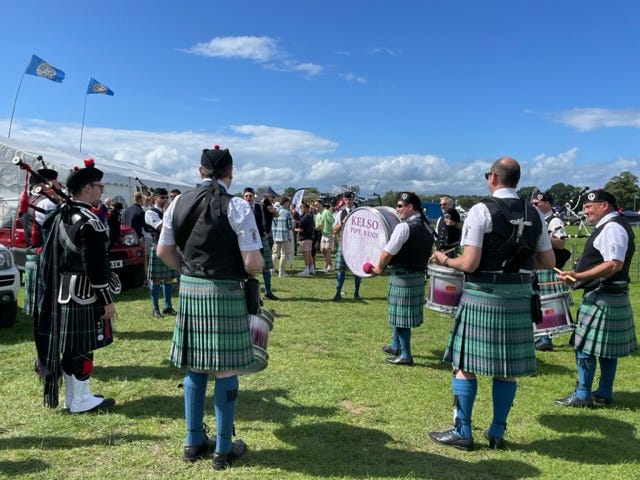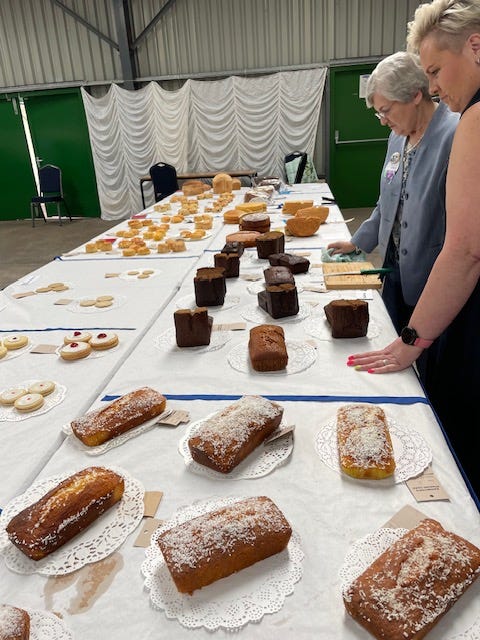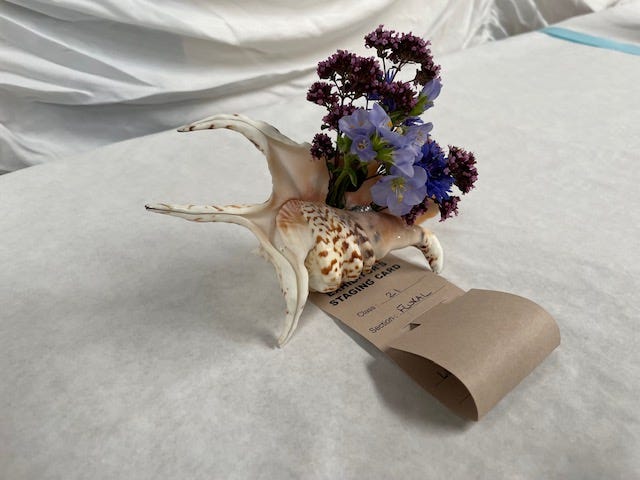Scottish Borders. 28th Jul. 2023
At the end of July, everything the earth has been working towards is ready for show. Hedgerows are shouting with wild cherries and raspberries, hillsides are lush with blaeberry, and autumn’s fruit is taking colour. In the garden harvests are rolling in and this week alone the freezer took three kilos of runner beans, broad beans and kale. After a long spring of thin promise, the abundance seems to arrive like a flash flood. I always feel drowned by the force of high summer, unable to find a firm foothold in the churning productivity. But it must be celebrated, because in an instant it is overripe.
And at this moment, the invitation to pause and appreciate appears in select fields and village halls, with marquees going up and cream teas being rolled out. Muddy livestock are pulled off the hills for their annual grooming, cakes are baked and marrows polished. The season of the country fair brings the serene and distant rural landscape into focus.
Country shows are some of the last communal celebrations of place in the UK. The smaller events around the Borders, with thier terrier races, displays of local craft and intimate numbers, are perhaps the best and most quintessential. But my favourite is still the Border Union Show at Kelso - less homespun, more commercial, but a fascinating overview of rural life.
This year the weather gods smiled on the Show. Dark clouds were pushed to the horizon where they mostly remained, creating a sense of all Border life being held in a vast bowl.
All the nuts and bolts of country life were on display, with insurance companies, estate agents and machinery merchants sitting alongside political party tents, conservation charities and pro-hunting organisations. Within half an hour, Jim and I had booked someone to test our water supply, quaffed a locally brewed pint, bought an expensive jumper, and garnered the gossip on which names are currently favoured, and who is at odds with whom.
A demonstration of tattie picking, the old fashioned way
But across from the stands is where the real tension happens. Young girls on ponies make their first public jumps, equine breeding is put to the test, and upright bodies whirr along in gleaming carriages. A tannoy details dates and credentials and chests swell or cheeks burn with the moment of recognition.
Around the outside of the show, beasts of all shapes, sizes and breeds, contribute the authentic scent of farming. Prize flanks and desired confirmations are scrutinised, and fertility assessed. One bull, a living Rubens, had just won first prize and was being calmly returned to his pen. His awesome heft made my senses crackle, but his handler moved as if he was leading a lamb on a string.
Someone hollered, ‘Do well?’.
‘Aye’, came the gruff response. But I saw him, whispering into his bull’s ear as if no-one was watching, ‘We did well, didn’t we…’.
The Kelso Show has been a locus for trading livestock and knowledge for generations, and I feel a real respect as I walk amongst those who carry that tacit understanding. It is a privilege to witness the skills and livelihoods which shape my landscape but which are normally far from public view.
And I am always comforted by the reliable display of tweed, worn out of respect for a common heritage, although donned differently by all.
There are battered jackets, brushed hard and pulled over bodies misshapen by decades of hard graft. Crisp, gaudy tweed, worn over designer jeans and smooth, tanned skin. And then a subdued fabric imbued with the weighty scent of cedar lined wardrobes, obedient whippets and gunpowder. All three weave through the show, living very different lives shaped by love of the same land.
For the first time I had a legitimate, if somewhat ill-fitting, role at the show this year. A strange series of events had seen me coopted into being steward for the bizarrely named ‘industrial tent’ - where amateur bakers, florists and crocheters compete for glory and silver cups. I was instructed to arrive early and meet ‘Jenny’ in ‘Big Cakes’. A giant shed, cleared of livestock and spruced with frilly cloths, was lined with trellis tables already filling with empire biscuits and lemon drizzles. I walked behind two judges, both named Wilma, and watched them ruthlessly sever Victoria sponges and fruit loaves in half to examine consistency and colour.
The moment of judgement.
Judgements were passed and tickets in primary colours applied. Once the cakes were bagged and secured under vast sheets of polythene, I took myself around to investigate all the other sections - knitted tea cosies, photos of pets, evergreen arrangements, soup in flasks. It felt a little like a trip back to the 1950s.
From the catergory, ‘Best Flower Arrangement in a Shell’
One lady, who had won more prizes than anyone else, bemoaned the fact that entry numbers had fallen year on year. Perhaps, she wondered, people weren’t into home crafts anymore? Children certainly didn’t learn it in school.
I thought of the myriad Instagram accounts I’d seen, showing off home baking and DIY decor. I thought of the boom in recipe book publishing and the national love of Bake Off. Despite the fact that we can buy almost everything cheaper than it can be made, the desire to craft it ourselves is clearly still strong, superseded only by our drive to show it off. Why then, would droves not bring their picture perfect food-porn here and glean an even greater audience? I would hazard a guess that displaying domestic virtue IRL might be uncomfortably unpredictable for those used to the controlled, sterile and odourless platform of social media.
I tried not to imagine a day when cattle would be judged via Facebook, or equine skills assessed by AI. Competition aside, there is something deeply human about being willing to share our abilities and fallibilities, alongside our experiences and knowledge, in real time and in person. We all know how curated the world of social media really is. And it cannot match the intangible, precious exchange which makes a country show buzz with life.







